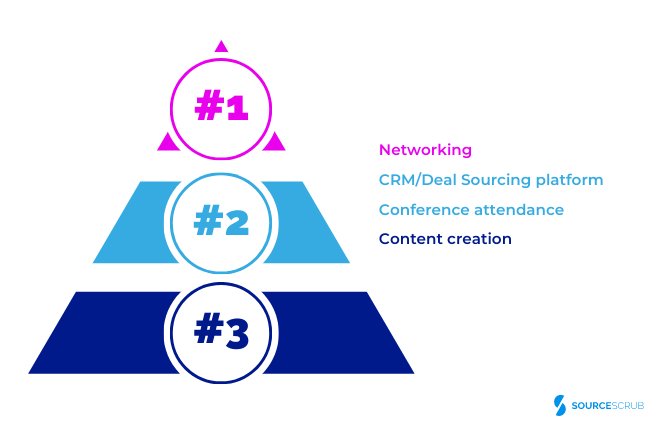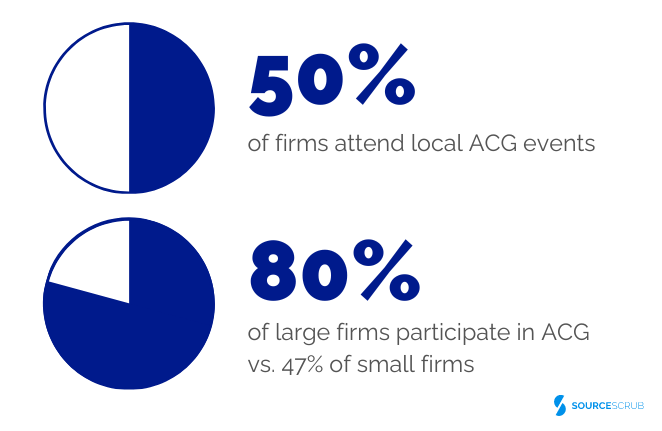
Technology has reshaped traditional business models, and private equity must adapt to this new dealmaking landscape to stay ahead of the curve "and the competition. To gain deeper insight into how firms are approaching these changes, we partnered with our friends at PrivateEquityCareer.com to conduct a survey that gauges the current state of technology adoption among dealmakers.
Our survey targeted professionals from nearly 100 private equity firms, ranging from emerging market entrants to large, established players with more than $1 billion AUM. We asked them about their current dealmaking practices, what they consider most important to their success, and how they're using tech to gain proprietary advantages. Let's review the results.
Private equity is a people business, which is why it's no surprise that survey respondents consider networking "emailing, calling, and meeting with business owners and intermediaries "the most important deal sourcing activity. Attending conferences and using CRM and deal sourcing platforms are considered the next most important, while content creation "creating white papers and blogs, social media, and podcasts and videos "are least important of all.

While conferences aren't ranked as the most important activity, firms are definitely still taking part in their fair share of trade shows. Respondents average 6 conferences per year, with larger firms (those with over $1 billion AUM) attending just one more event per year on average than smaller firms, despite having more available resources.
Local Association for Corporate Growth (ACG) events are the most popular, with half of firms saying they attend. Interestingly, while nearly 60% of large firms attend ACG's flagship conference, DealMAX (previously known as Intergrowth), just 30% of smaller firms make it to Las Vegas for the event. The majority of large firms (80%) are also active in ACG's association, compared to just 47% of small firms.

While traditional dealmaking methods such as networking and conferences are likely to remain popular among dealmakers, the contrast between firms' belief in the importance of tech and their general lack of tech use is stark. When asked which of the 14 most common CRM and deal sourcing platforms they use, respondents rank Microsoft Excel as the most popular.
The spreadsheet program can do wonders for certain activities, such as data analysis, but the fact that many firms seem to be using it as a CRM is indicative of dealmakers' slow technology adoption. There are higher performing, purpose-built options that offer more useful features and functionality that streamline and improve dealmaking processes, yet less than 10% of survey respondents take advantage of most of these tools.
However, larger firms report using more technology and more robust CRMs compared to smaller firms, with 10% more using DealCloud and nearly twice as many using Salesforce. Even Microsoft Dynamics, the least popular CRM among large-firm respondents, is used by more than 4x as many large firms as small.

.png)
Our survey also found respondents from large firms use data service providers more often. For example, 17% of surveyed large firms use Sourcescrub's deal sourcing platform compared to 13% of small firms, and nearly 3x as many (20%) large firms use Sutton Place Strategies (SPS) as small firms (7%).
To better understand how firms' dealmaking strategies and tech use are affecting their deal flow, we asked respondents about their annual activities. From deals logged to platform and add-on acquisitions made, we collected estimates across the entire deal flow process.
Small firms cite an average of 525 deals/teasers logged per year, with an average of 238 offering memorandums. From that, they report a respectable 25 letters of intent, but just 3 successful acquisitions (1 platform and 2 add-ons) last year, on average.
Large firms paint quite a different picture: they claim an average of 798 deals/teasers logged per year, with an average of 316 offering memos. Then, they report just 30 letters of intent, but a staggering 21 successful acquisitions (4 platforms and 17 add-ons), on average, in 2022.
Despite having a lower conversion rate at each stage of the deal flow process, large firms report a much higher close rate and number of acquisitions than smaller firms "7.3x as many, to be exact. This boils down to larger firms having a significantly higher conversion rate (2.63%) from beginning to end in their deal flow process compared to small firms (0.57%).
Considering these firms' increased use of tech, our survey results would seem to indicate that using data and technology enables firms to better refine their investment theses, learn more about target opportunities, spend more time on the deals with the most potential, and, most importantly, close more deals.
As we have seen time and time again, technology in private equity helps firms realize significant gains. For firms to stay ahead of the curve and better tackle the challenges and changes in the private equity landscape, building a robust tech stack should be on their list of top projects for this year.
It's time to get ahead of your competition. Read our guide on the Modern Dealmaker's Tech Stack to learn the three core components that should be in your tech stack, plus one that will set your firm up for success both now and in the future.
Want to see more results from our survey with PrivateEquityCareer.com? You can access the full report here.